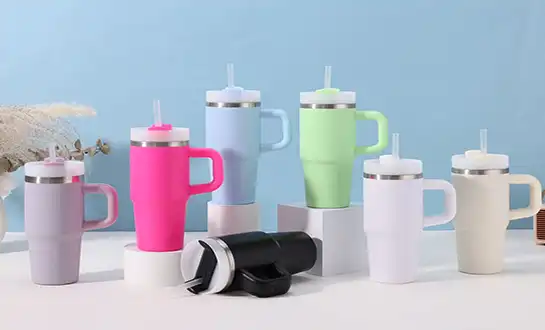Understanding the Manufacturing Process of Wholesale Stainless Steel Tumblers
The manufacturing process of wholesale stainless steel tumblers represents a fascinating intersection of advanced metallurgy, precision engineering, and innovative design principles that have revolutionized the drinkware industry. Understanding this intricate process is essential for businesses seeking to source high-quality stainless steel tumblers that meet both functional requirements and aesthetic expectations. From the initial material selection of premium 304 stainless steel to the final quality control inspections, each step in the manufacturing journey contributes to creating durable, thermally efficient, and visually appealing drinkware products. Modern manufacturers like Hangzhou Topnovo Co., Ltd have perfected these processes through years of experience, combining traditional craftsmanship with cutting-edge automation to produce stainless steel tumblers that serve diverse market needs while maintaining consistent quality standards across large-scale production runs.
Material Selection and Quality Standards for Stainless Steel Tumblers
The foundation of any superior stainless steel tumbler begins with meticulous material selection, where manufacturers prioritize food-grade stainless steel alloys that ensure both safety and performance. The most commonly utilized material is 304 stainless steel, also known as 18/8 stainless steel, which contains 18% chromium and 8% nickel, providing exceptional corrosion resistance and durability. This particular grade of stainless steel is non-reactive, meaning it won't impart metallic tastes to beverages or interact with acidic drinks, making it ideal for stainless steel tumblers intended for diverse beverage applications. The manufacturing process demands strict adherence to international quality standards, with suppliers providing certified materials that meet FDA requirements and other regulatory compliance measures. Quality control begins at this initial stage, where incoming materials undergo rigorous testing for chemical composition, tensile strength, and surface quality to ensure they meet the specifications required for premium drinkware production.
Advanced Manufacturing Techniques in Stainless Steel Tumbler Production
The actual production of stainless steel tumblers involves sophisticated manufacturing techniques that transform raw materials into finished products through multiple precision-controlled processes. Deep drawing is the primary forming method, where flat stainless steel sheets are shaped into cylindrical forms using specialized hydraulic presses and custom-designed dies. This process requires careful temperature control and lubrication to prevent material stress and ensure uniform wall thickness throughout the tumbler body. Following the initial forming, the tumblers undergo precision machining to achieve exact dimensional specifications, with tolerances measured in fractions of millimeters to ensure consistent fit and finish. The 16 oz stainless steel can tumbler, measuring 6.7×7.8×14.6cm and weighing 207g, exemplifies the precision achievable through modern manufacturing techniques, where every dimension is carefully controlled to meet both functional and aesthetic requirements.
Double-Wall Vacuum Insulation Technology
One of the most critical aspects of stainless steel tumbler manufacturing is the implementation of double-wall vacuum insulation technology, which provides superior thermal performance for both hot and cold beverages. This process involves creating two separate stainless steel walls with a vacuum space between them, effectively eliminating heat transfer through conduction and convection. The manufacturing process requires specialized welding techniques to seal the vacuum chamber while maintaining structural integrity, with laser welding being the preferred method for its precision and reliability. The vacuum creation process involves removing air from the space between walls using specialized equipment, followed by permanent sealing to maintain the vacuum over the product's lifetime. This technology enables stainless steel tumblers to maintain beverage temperatures for extended periods while preventing condensation on the exterior surface, making them sweat-free when containing cold drinks and safe to handle when filled with hot beverages.
Surface Treatment and Finishing Processes
The surface treatment and finishing processes for stainless steel tumblers encompass a wide range of techniques that enhance both appearance and functionality while providing opportunities for customization. Original stainless steel finishes showcase the natural beauty of the material, while various coating options allow for enhanced aesthetics and brand differentiation. Powder coating represents one of the most popular finishing methods, providing durability and a wide range of color options, including single-color applications and sophisticated ombre effects that transition between multiple colors. Advanced finishing techniques include matte painting for subtle elegance, glossy painting for vibrant appearance, glitter painting for eye-catching effects, and even luminous paint for unique nighttime visibility. Specialized treatments like ice flower paint create unique textural patterns, while electroplating can provide metallic finishes that enhance the premium appearance of stainless steel tumblers. Each finishing process requires specific preparation steps, including thorough cleaning, surface preparation, and controlled application environments to ensure optimal adhesion and longevity.
Customization and OEM/ODM Manufacturing Capabilities
Modern stainless steel tumbler manufacturing has evolved to accommodate extensive customization options through comprehensive OEM and ODM services that allow brands to create unique products tailored to their specific requirements. The customization process begins with detailed consultations between manufacturers and clients to understand design objectives, functional requirements, and branding needs. Shape customization represents one of the most complex aspects of the process, requiring at least three months of development time that includes initial concept discussions, 3D drawing creation, prototype development within seven days, mold manufacturing taking 35-65 days, and multiple sample confirmations before bulk production begins. Lid customization offers additional opportunities for differentiation, with manufacturers providing various closure options including straw-compatible designs, flip-top mechanisms, and threaded caps that enhance user convenience while maintaining thermal performance. Logo application techniques have advanced significantly, offering multiple options for brand representation on stainless steel tumblers. Silkscreen printing provides cost-effective solutions for simple designs, while laser engraving creates permanent, elegant markings that won't fade or wear over time. Embossing creates raised logo designs that provide tactile appeal, while heat transfer and 3D UV printing enable complex, multi-color graphics with exceptional detail. Advanced techniques like water decal application and air transfer methods allow for intricate designs that wrap around curved surfaces seamlessly, providing unlimited creative possibilities for brand expression.
Quality Control and Testing Procedures
The manufacturing process of stainless steel tumblers incorporates comprehensive quality control procedures that ensure every product meets stringent performance and safety standards before reaching consumers. A typical quality control process involves twenty distinct inspection steps that examine various aspects of construction, functionality, and appearance throughout the manufacturing cycle. Initial inspections focus on raw material verification, ensuring that incoming stainless steel meets chemical composition requirements and surface quality standards. During production, dimensional checks verify that each tumbler conforms to specified measurements, while weld integrity testing ensures that vacuum seals will maintain their effectiveness over time. Thermal performance testing represents a critical component of quality assurance, where finished tumblers undergo standardized temperature retention tests to verify their insulation capabilities. These tests typically involve filling tumblers with liquids at specific temperatures and monitoring temperature changes over predetermined time periods, ensuring that products meet advertised performance claims. Surface finish quality inspections examine coating adhesion, color consistency, and overall appearance, while logo application quality checks verify that branding elements meet visibility and durability requirements. The comprehensive nature of these quality control procedures, combined with the experience of manufacturers like Topnovo who maintain a 98% on-time shipping record and achieve zero complaints from 86% of customers who have cooperated for over six years, demonstrates the effectiveness of rigorous quality management systems.
Environmental Considerations and Sustainable Manufacturing
Contemporary stainless steel tumbler manufacturing increasingly emphasizes environmental sustainability and responsible production practices that minimize ecological impact while maintaining product quality. Stainless steel itself represents an environmentally friendly material choice due to its complete recyclability and longevity, reducing the need for frequent replacement and minimizing waste generation. Manufacturing processes have been optimized to reduce energy consumption through efficient equipment design and improved production workflows that minimize material waste and maximize resource utilization. Water-based coating systems and powder coating technologies reduce volatile organic compound emissions compared to traditional solvent-based finishes, contributing to cleaner manufacturing environments and reduced environmental impact. Packaging innovations focus on using recyclable materials and minimizing packaging volume to reduce transportation-related emissions while maintaining product protection during shipping. Many manufacturers have implemented closed-loop water systems that recycle process water, reducing consumption and minimizing wastewater discharge. These environmental considerations align with growing consumer demand for sustainable products and corporate responsibility, making environmentally conscious manufacturing practices both ethically important and commercially advantageous.
Conclusion
The manufacturing process of wholesale stainless steel tumblers represents a sophisticated blend of advanced technology, quality craftsmanship, and innovative design that creates products capable of meeting diverse consumer needs while maintaining exceptional performance standards. From material selection through final quality control, each step contributes to producing durable, functional, and aesthetically pleasing drinkware that serves both practical and promotional purposes. Understanding these manufacturing processes helps businesses make informed sourcing decisions and appreciate the complexity behind seemingly simple products.
Ready to experience the difference that professional manufacturing expertise can make for your drinkware needs? Topnovo's commitment to excellence shines through our comprehensive quality control process, innovative R&D capabilities, and flexible OEM/ODM services that transform your concepts into market-ready products. With BSCI, FDA, and Lead-Free certifications backing our manufacturing processes, plus a proven track record of 98% on-time delivery and zero complaints from long-term partners, we're positioned to become your trusted manufacturing partner. Whether you need custom shapes, unique finishes, or specialized packaging solutions, our experienced team is ready to help you create stainless steel tumblers that exceed expectations and drive business success. Contact us today at sales01@topnovolife.com to discuss how we can bring your drinkware vision to reality with precision, quality, and reliability that sets your brand apart in the competitive marketplace.
References
1. Chen, L., & Wang, M. (2023). Advanced Metallurgy in Stainless Steel Drinkware Manufacturing: A Comprehensive Analysis. Journal of Materials Engineering and Production Technology.
2. Rodriguez, P., Thompson, K., & Lee, S. (2024). Vacuum Insulation Technology in Modern Thermoware: Performance Optimization and Quality Control. International Review of Thermal Engineering Applications.
3. Anderson, J., & Kumar, R. (2023). Surface Treatment Innovations in Stainless Steel Product Manufacturing. Materials Science and Industrial Applications Quarterly.
4. Wilson, D., Zhang, H., & Martinez, C. (2024). Quality Management Systems in Large-Scale Drinkware Production: Best Practices and Industry Standards. Manufacturing Excellence Review.
5. Brown, A., & Singh, P. (2023). Sustainable Manufacturing Practices in the Stainless Steel Industry: Environmental Impact and Economic Benefits. Journal of Sustainable Industrial Processes.
6. Taylor, R., Liu, X., & Johnson, M. (2024). Customization Technologies in Modern Drinkware Manufacturing: From Design to Production. Industrial Design and Manufacturing Innovation.

Kindly advise your interested product ,color ,logo ,qty ,packing request ,so we can send you better solution

Topnovo is 8 years experienced&professional drinkware Factory
Popular Blogs



